Albany is home to a diverse array of birds, including many species of native and migratory species. From the colorful variety of songbirds to the majestic bald eagles that soar over the city, you can find a variety of bird species in Albany.
Birdwatching is a popular pastime in Albany and its surrounding areas, and the city is home to some of the most popular bird-watching sites in the region. Whether you’re a seasoned birder or a beginner, you’ll find plenty of birds to observe in Albany.
With its many parks, lakes, and rivers, there are plenty of opportunities to spot a wide variety of birds in their natural habitats.
1. Great Blue Heron
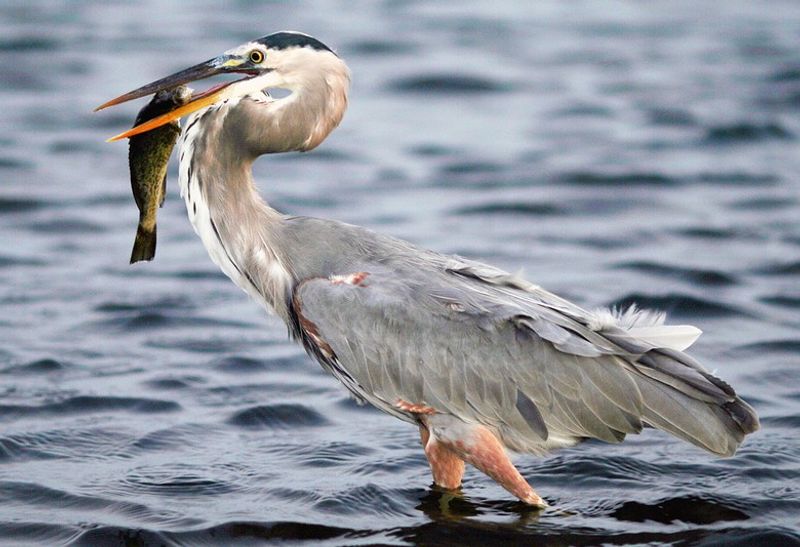
The great blue heron is a majestic wading bird that is part of the heron family Ardeidae. It is widely distributed throughout North and Central America, as well as far northwestern South America, the Caribbean, and the Galápagos Islands.
This species of heron is usually found near the shores of open water and in wetlands. It has a unique appearance, with its long legs and S-shaped neck.
The great blue heron is often seen standing or walking slowly in shallow water, searching for small fish, frogs, crustaceans, and insects. It typically stands still when it spots prey before quickly striking with its long, sharp bill.
This species of heron can be seen gliding gracefully through the air or perched atop trees and branches near bodies of water. Its long wingspan and distinctive silhouette make it instantly recognizable.
The great blue heron is an important part of the wetland ecosystem, as its presence helps to keep populations of small prey species in check.
This species of heron is a beloved sight for birdwatchers, and its presence is a reminder of the beauty and importance of these vital habitats.
| Kingdom | Animalia |
| Phylum | Chordata |
| Class | Aves |
| Order | Pelecaniformes |
| Family | Ardeidae |
| Genus | Ardea |
| Species | A. herodias |
2. Red-Tailed Hawk
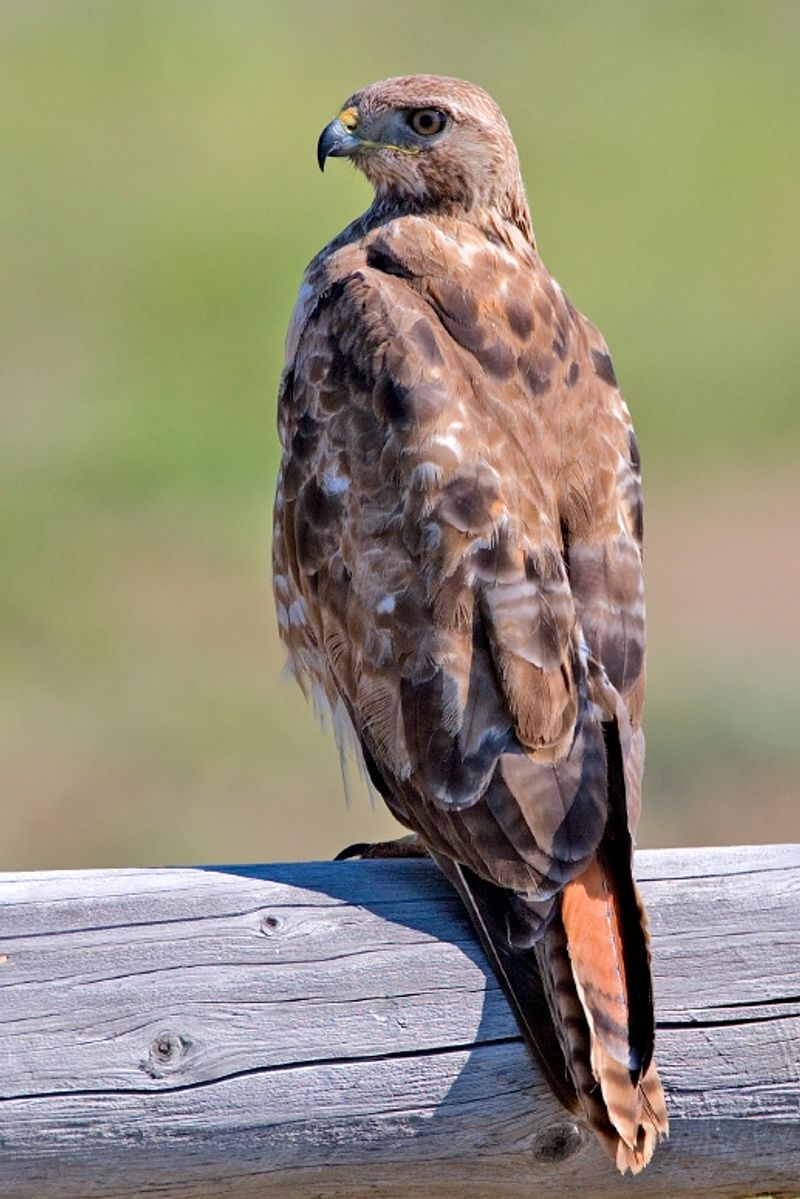
The red-tailed hawk is a bird of prey that is widely distributed throughout North America and parts of Central America. This species is found from northern Alaska and Canada down to the tropical regions of Panama and the West Indies.
The red-tailed hawk is a member of the Buteo genus and is one of the most common species within this group in North America and worldwide. The red-tailed hawk is a large bird of prey, with a body length of 16-26 inches and a wingspan of 3.5-4.5 feet.
They are easily identifiable by their namesake red tail and have a variety of plumage colors, ranging from pale gray to dark brown and black.
The red-tailed hawk has a powerful beak for tearing their prey and strong talons for grasping it. These birds of prey typically hunt for small mammals like mice and voles in open fields but also eat birds, reptiles, amphibians, and other small prey.
They have keen vision and can spot prey from long distances away.
They can also soar for long periods of time, using thermals to stay airborne and conserve energy. The red-tailed hawk is an important bird species in North America and is an indicator of the health of our environment.
They are protected by the Migratory Bird Treaty Act and the Endangered Species Act and are a species of special concern in some states. With proper conservation and management, this species should continue to thrive in our environment for generations to come.
| Kingdom | Animalia |
| Phylum | Chordata |
| Class | Aves |
| Order | Accipitriformes |
| Family | Accipitridae |
| Genus | Buteo |
| Species | B. jamaicensis |
3. Red-Winged Blackbird
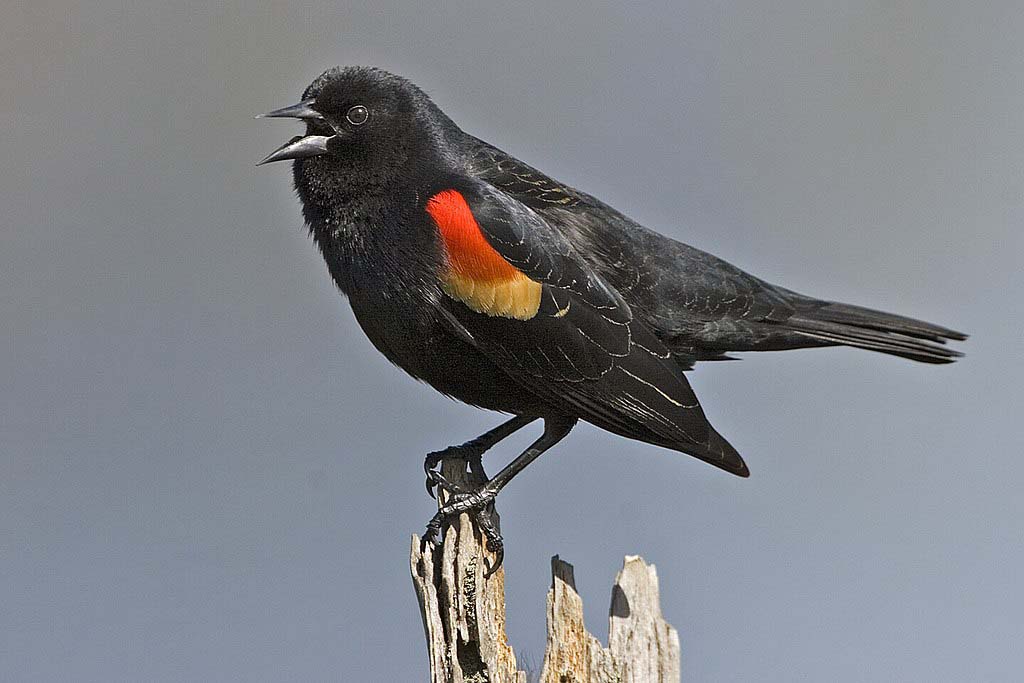
Source: Wikipedia
The Red-winged Blackbird is a species of passerine bird belonging to the family Icteridae. They are found in a large portion of North America and Central America.
This species of bird is easily recognizable as it has a glossy black body with bright red and yellow patches on its wings. Additionally, its tail is usually streaked with black and white.
The Red-winged Blackbird is a migratory species, which means that it follows seasonal patterns in order to move from one place to another. It spends its winters in Mexico and Central America, then migrates north in the spring.
During the summer months, it can be found in most parts of the United States and Canada. The Red-winged Blackbird is most often found in open land, such as meadows, fields, and marshes.
It feeds on insects, grains, and seeds, and is especially fond of waste grain found in agricultural fields.
It also frequents bird feeders and is often seen in large flocks in open areas. The Red-winged Blackbird is known for its loud, melodic song, which is often heard in the spring and summer months.
This species plays a vital role in the ecosystem, as it helps to control insect populations and disperse seeds. It is a common sight in many parts of North America and is a beloved bird for both its beauty and its song.
| Kingdom | Animalia |
| Phylum | Chordata |
| Class | Aves |
| Order | Passeriformes |
| Family | Icteridae |
| Genus | Agelaius |
| Species | A. phoeniceus |
4. Red-Shouldered Hawk
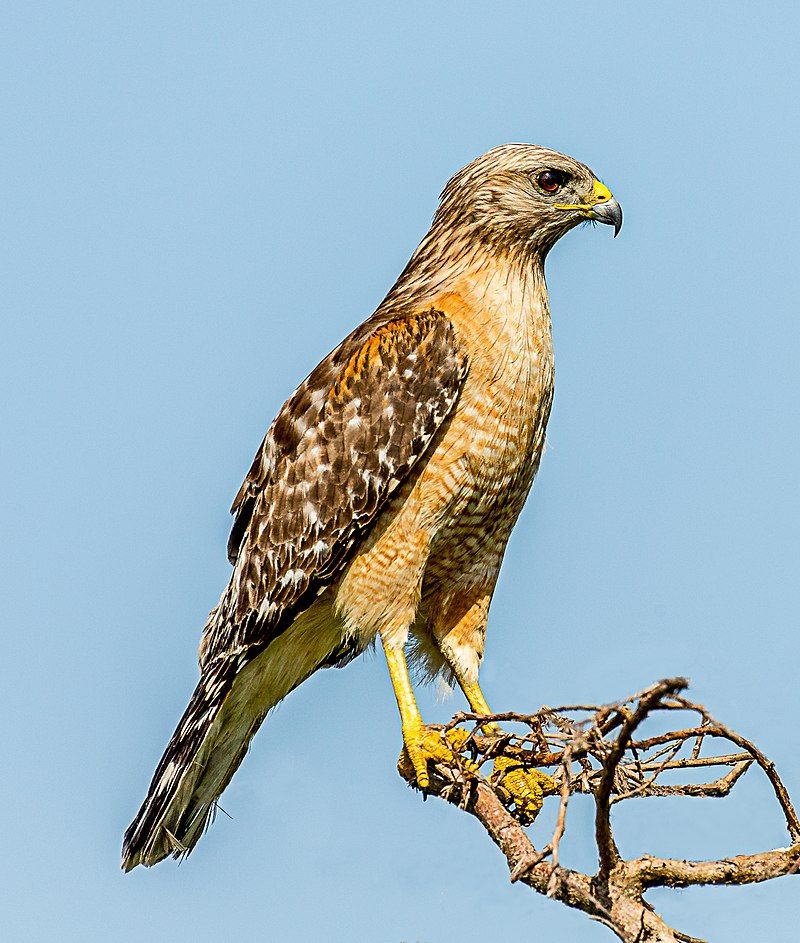
The red-shouldered hawk is a medium-sized buteo, meaning it is a type of hawk. It has a wide breeding range, which spans eastern North America as well as along the coast of California and northern to northeastern-central Mexico.
This species of hawk is a permanent resident throughout most of its range, with the exception of the northern birds, which migrate mainly to central Mexico for the winter season.
The red-shouldered hawk is one of the few species of hawk that migrates regularly, and its range covers a large area of land. This species is also known for its distinctive red-shouldered feathers, which make it easily identifiable among other types of hawk.
| Kingdom | Animalia |
| Phylum | Chordata |
| Class | Aves |
| Order | Accipitriformes |
| Family | Accipitridae |
| Genus | Buteo |
| Species | B. lineatus |
5. American Robin
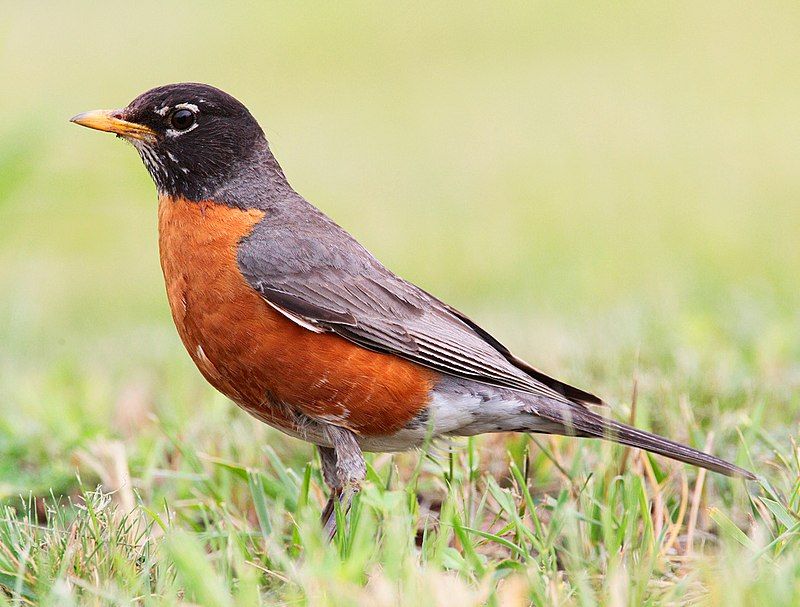
The American robin is a species of migratory bird that belongs to the true thrush genus and Turdidae family, which is in the wider thrush family of birds. It is called the American robin because its breast is orange-red, just like the European robin.
However, these two species are not closely related, as the European robin is part of the Old World flycatcher family. The American robin is found throughout the United States and Canada, and it is one of the most recognizable birds in North America.
It is easily identified by its orange-red breast, gray back and wings, and black head. The American robin prefers to live in wooded areas and is often seen near trees or in gardens. It is a very social bird, and can often be seen in flocks of up to 50 individuals.
The American robin is an omnivore, and its diet consists of earthworms, insects, fruits, and berries. During the summer months, it can be seen foraging in fields and lawns for insects and worms. During the winter months, it will feed on berries and other fruits.
In addition to its diet, the American robin also consumes grit to help it digest its food. The American robin is a beautiful sight to see, and it serves as an important part of the natural ecosystem.
It helps to control insect populations and also helps to disperse the seeds of various fruits and berries. It is a symbol of resilience and endurance, as it is able to survive and thrive in a variety of habitats.
Despite its popularity, the American robin is listed as a species of Least Concern by the International Union for Conservation of Nature (IUCN).
| Kingdom | Animalia |
| Phylum | Chordata |
| Class | Aves |
| Order | Passeriformes |
| Family | Turdidae |
| Genus | Turdus |
| Species | T. migratorius |
6. Eastern Bluebird
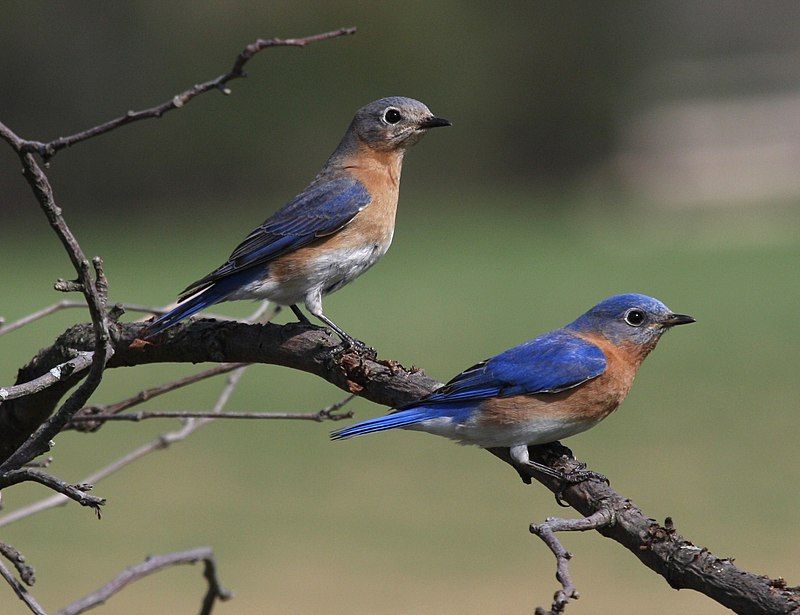
The Eastern Bluebird is a small thrush bird native to North America. It is migratory and can be found in open woodlands, farmlands, and orchards. It is known for its bright-blue plumage of the male, which stands out against its natural habitat, making it a favorite of birders.
The Eastern Bluebird is often seen perched on a wire or open perch, making it easily observable even from far away. The Eastern Bluebird is a magnificent bird, with its vivid blue coloring and its ability to thrive in a variety of habitats.
Its popularity amongst birders is a testament to its majestic beauty, with its bright-blue plumage providing a stunning contrast to its natural environment.
| Kingdom | Animalia |
| Phylum | Chordata |
| Class | Aves |
| Order | Passeriformes |
| Family | Turdidae |
| Genus | Sialia |
| Species | S. sialis |
7. American Kestrel
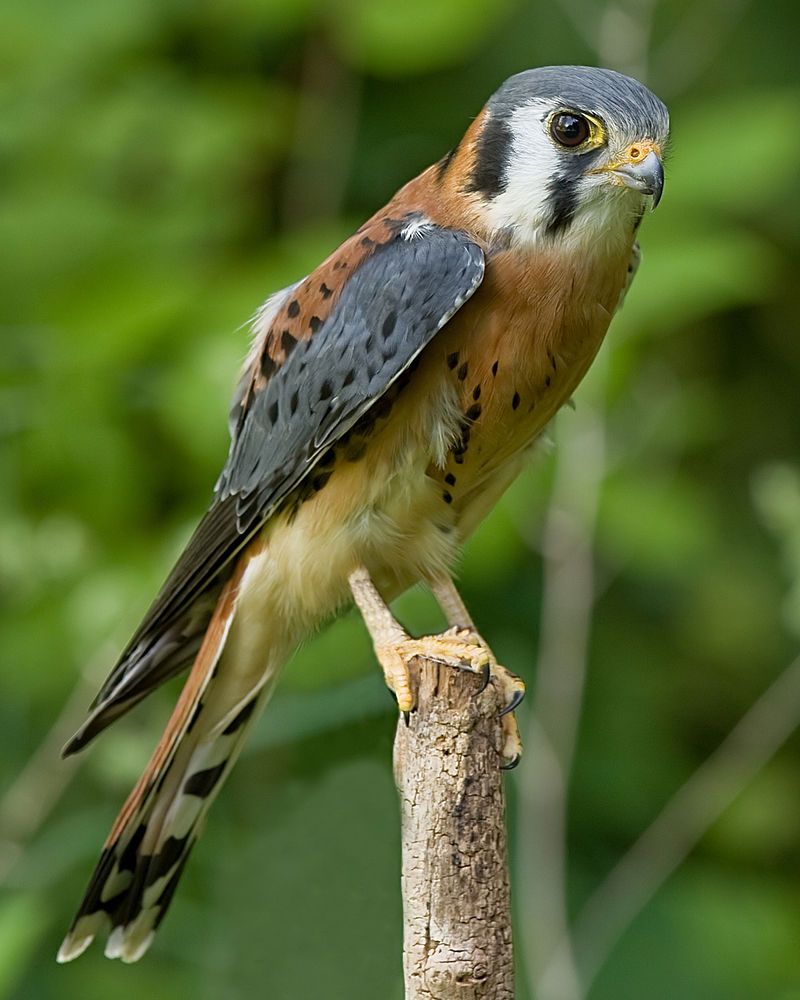
The American kestrel, also known as the sparrow hawk, is an incredibly common and diverse species of falcon that inhabits North America.
This species of falcon has a wide range in size, with the smallest of the species being roughly the same weight as a blue jay and the largest of the species being similar in size to a mourning dove.
The variety in size is further accentuated by the differences between the sexes and the various subspecies. The American kestrel is a colorful bird, with males typically sporting a reddish-brown back and tail, barred wings, and a spotted breast.
Females tend to be a bit darker, with a grayish-brown back and tail, barred wings, and a spotted breast. Both sexes feature a distinctive white facial stripe between the eyes and bill, a rusty tail, and yellowish legs and feet.
This species of falcon is found in open grasslands, pastures, and shrublands, but they can also inhabit wooded areas and even urban environments. American kestrels feed mainly on insects, but they are also known to eat small mammals, reptiles, and other birds.
They nest in cavities, but they are also known to use artificial nest boxes and other man-made structures. The American kestrel is an incredibly adaptable species that can be found in many different habitats throughout North America.
Its wide range in size and its colorful plumage makes it a particularly interesting species to observe.
| Kingdom | Animalia |
| Phylum | Chordata |
| Class | Aves |
| Order | Falconiformes |
| Family | Falconidae |
| Genus | Falco |
| Species | F. sparverius |
8. Osprey
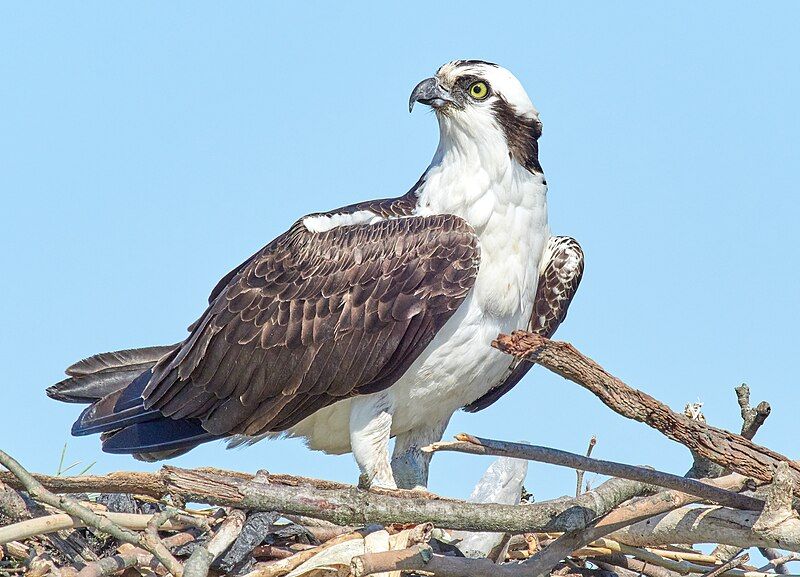
The osprey is a large bird of prey, commonly referred to as a sea hawk, river hawk, or fish hawk. It has a widespread habitat, found in many parts of the world. It is diurnal, meaning it is active during the day and feeds mainly on fish.
The Osprey is quite large, measuring over 60 centimeters in length and 180 centimeters across the wings. Its coloring is mainly brown on its upperparts, and a light grey on its head and underparts.
| Kingdom | Animalia |
| Phylum | Chordata |
| Class | Aves |
| Order | Accipitriformes |
| Family | Pandionidae |
| Genus | Pandion |
| Species | P. haliaetus |
9. White-Crowned Sparrow
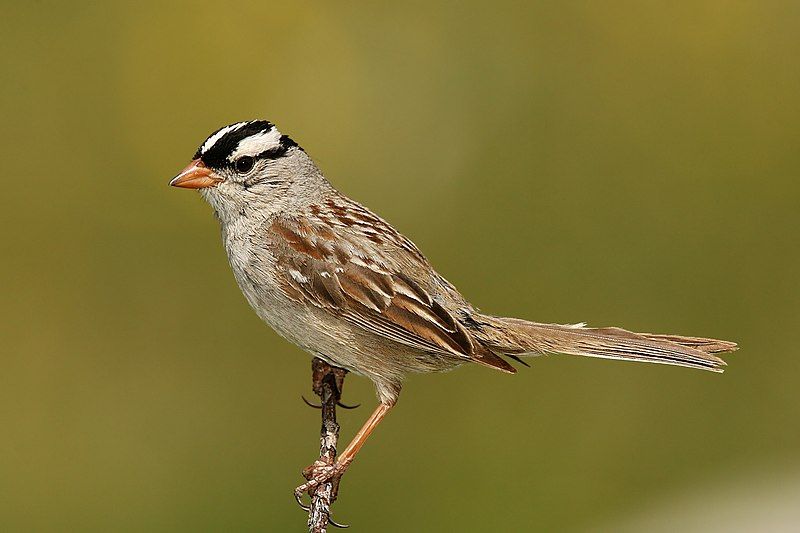
The white-crowned sparrow is a species of bird that is native to North America. It is a medium-sized bird, belonging to the New World sparrow family. It is distinguished from other birds by its grey face and the black and white streaking on the upper head.
These birds are a sight to behold, with their distinct markings and unique colors. The white-crowned sparrow is found in various parts of North America, from the northwest to the southwest of the continent.
It is a ground-dwelling bird, found in open fields, meadows, and woodlands. They often feed on the ground, eating insects, seeds, and grains.
They are also known to eat berries and fruits from time to time. The white-crowned sparrow is an important part of the North American avian population. It is a migratory species, with some populations wintering in the south and others staying in the north.
This species plays an important role in maintaining the balance of the North American ecosystem. The white-crowned sparrow is a species of great beauty and grace. Its distinct markings and unique colors make it an unmistakable sight in the wild.
Its presence is a reminder of the beauty and diversity of the North American avian population and its importance in the balance of the ecosystem.
| Kingdom | Animalia |
| Phylum | Chordata |
| Class | Aves |
| Order | Passeriformes |
| Family | Passerellidae |
| Genus | Zonotrichia |
| Species | Z. leucophrys |
10. Chestnut-Backed Chickadee
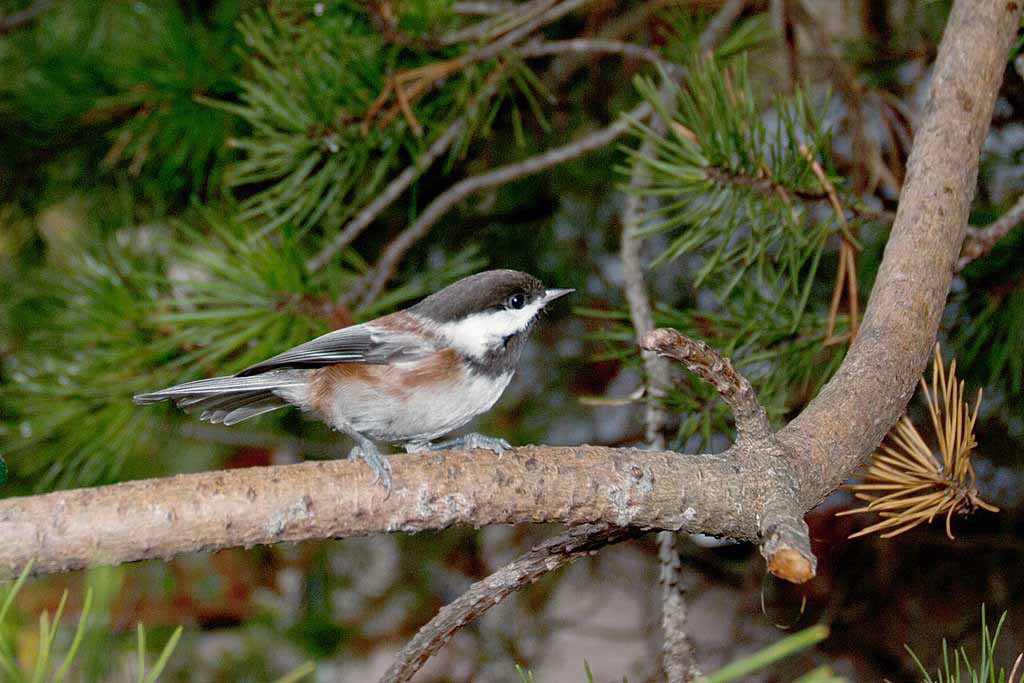
The chestnut-backed chickadee is a species of bird that belongs to the tit family of birds, Paridae. It is found in the Pacific Northwest region of the United States and western Canada, from southern Alaska to southwestern California.
It was formerly known as Parus rufescens. The chestnut-backed chickadee is a small bird, usually measuring between five and seven inches in length. It has a brownish-gray body with a white belly and a black cap. Its wings and tail are a dark grayish-brown color.
The chestnut-backed chickadee also has a distinctive call, consisting of a series of double notes, “chick-a-dee-dee-dee”.The chestnut-backed chickadee is a common bird in the Pacific Northwest and can be found in a variety of habitats including coniferous forests, woodlands, and urban parks.
It feeds mainly on seeds and insects, and will also visit bird feeders. Its nests are made of twigs and moss and are usually found in tree cavities or nest boxes. The chestnut-backed chickadee is an important species for many reasons.
It is a pollinator for many plants and helps maintain healthy ecosystems. It is also an important source of food for predators such as hawks, owls, and other birds of prey.
Finally, it is a popular bird for birdwatchers and provides people with an opportunity to witness the beauty of nature.
| Kingdom | Animalia |
| Phylum | Chordata |
| Class | Aves |
| Order | Passeriformes |
| Family | Paridae |
| Genus | Poecile |
| Species | P. rufescens |
11. Dark-Eyed Junco
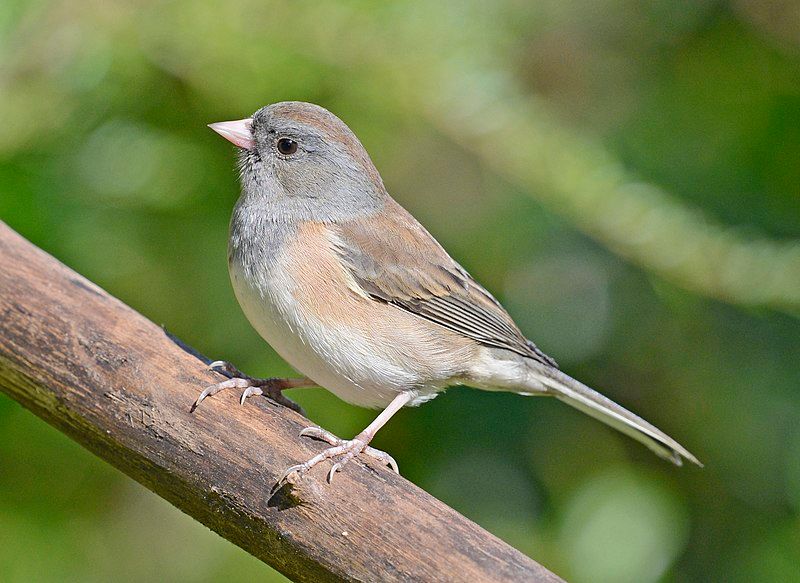
The dark-eyed junco is a species of junco, a family of small, grayish New World sparrows. This species of bird is found in a wide range of temperate North American areas and, during the summer months, can be seen as far north as the Arctic.
It is known for its wide range of variation in appearance, being quite similar to another species of sparrow, the fox sparrow. Despite its widespread distribution and varied physical characteristics, the exact systematics of the dark-eyed junco is still not fully understood.
This is likely due to its complex evolutionary history and ever-changing habitats. The dark-eyed junco is often seen in open woodlands, gardens, and grasslands, and is a popular species for bird watchers. Its size and coloration make it easy to spot among its surroundings.
It has a gray head, back, and wings, and a white underside, as well as a black stripe along the center of its chest. This species of bird is also known for its vocalizations, producing a variety of different songs and calls.
The dark-eyed junco is an important part of the food chain for many other species. It feeds mainly on insects and small invertebrates, but also eats fruits and seeds.
This species is also commonly seen in residential areas, often taking advantage of bird feeders to supplement its diet. The dark-eyed junco is an important species to the ecosystem, providing both food and shelter for many other animals.
Overall, the dark-eyed junco is a common species of bird found in temperate North America. It is a very variable species, much like the related fox sparrow, and its systematics are still not completely untangled.
Despite this, it is a popular species for bird watchers, providing an opportunity to observe its unique physical characteristics and vocalizations. It is also an important part of the food chain, providing food and shelter for many other species.
| Kingdom | Animalia |
| Phylum | Chordata |
| Class | Aves |
| Order | Passeriformes |
| Family | Passerellidae |
| Genus | Junco |
| Species | J. hyemalis |
12. Western Rosella
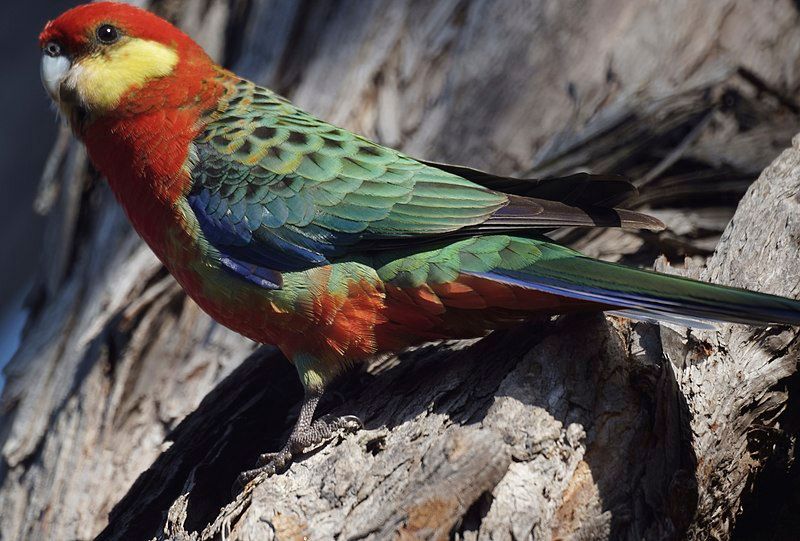
The western rosella, also known as the moya dong, is a species of parrot that is native to southwestern Australia. This species of parrot is easily identifiable by its bright red head and underparts, as well as a mottled black back.
What helps to differentiate the western rosella from other species of the genus Platycercus is a distinct yellow patch on its cheek. This patch can be seen even from a distance, making it an easy way to tell the western rosella apart from other parrots.
The western rosella is a stunning bird, with its bright colors, and its ability to stand out from other species of parrots.
| Kingdom | Animalia |
| Phylum | Chordata |
| Class | Aves |
| Order | Psittaciformes |
| Family | Psittaculidae |
| Genus | Platycercus |
| Species | P. icterotis |
13. Peregrine Falcon
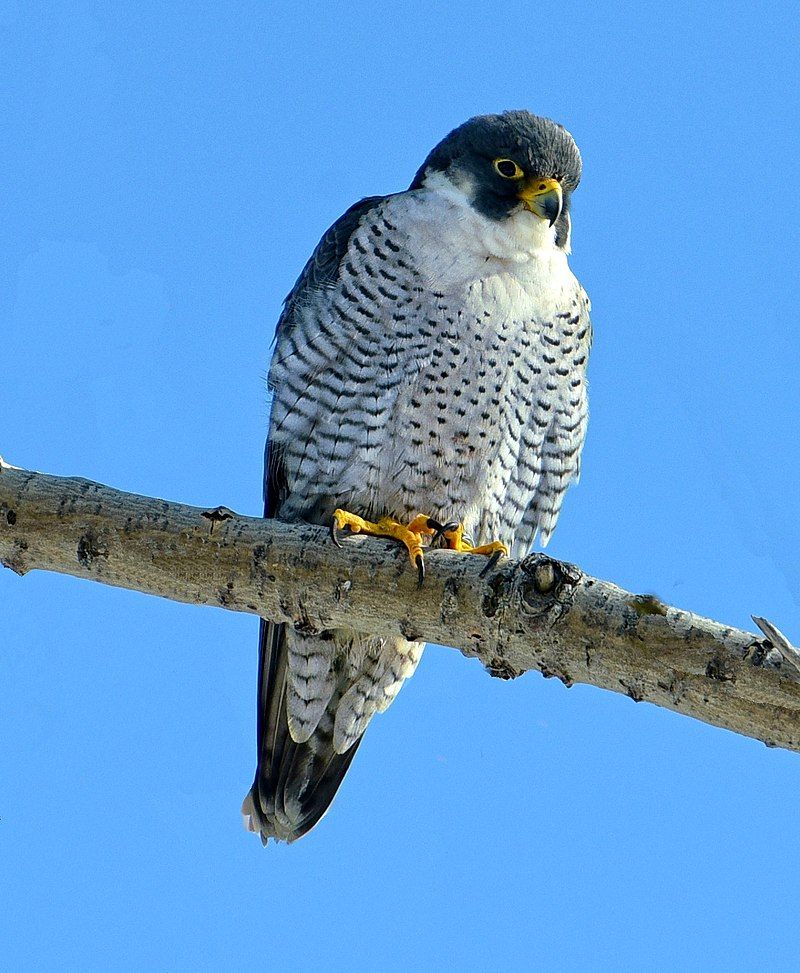
The peregrine falcon is a species of bird known for its speed and agility. It is an iconic figure in the animal kingdom and is found in many different regions and countries around the world.
The peregrine falcon is a large bird of prey, with a body size similar to that of a crow. Its back is a bluish-grey color, with white bars on its underside, and its head is black.
The peregrine has become well-known for its incredible speed, reaching speeds of up to 200 mph when diving for its prey. This makes it the fastest bird in the world and one of the fastest creatures on the planet.
Its speed and power allow it to hunt and survive in many different environments, including coastal areas, mountains, and open plains. It is a top predator, with a diet of mostly small birds, bats, and other animals.
The peregrine falcon is an impressive species, and its incredible speed makes it a sight to behold in the wild.
| Kingdom | Animalia |
| Phylum | Chordata |
| Class | Aves |
| Order | Falconiformes |
| Family | Falconidae |
| Genus | Falco |
| Species | F. peregrinus |
14. Ruby-Crowned Kinglet
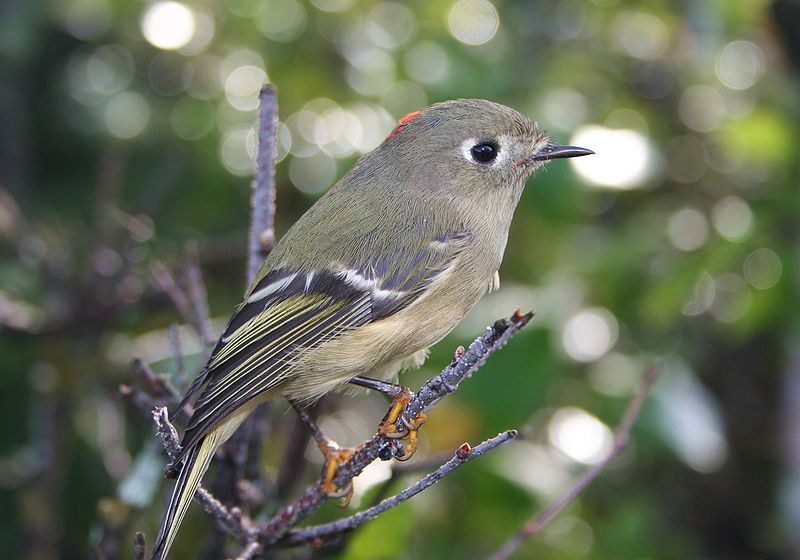
The ruby-crowned kinglet is a very small passerine bird found throughout North America. It belongs to the family of kinglets, a group of tiny birds with similar characteristics.
This bird is easily recognizable with its olive-green plumage, two white wing bars, and a white eye ring. Males have an additional distinguishing feature – a small red patch on their head, which is usually hidden.
This patch is the source of the bird’s name: ruby-crowned kinglet. The ruby-crowned kinglet is found in a variety of habitats, from woodlands and coniferous forests to open fields and gardens. It feeds on insects, spiders, and other small invertebrates.
Their diet also includes small fruits and seeds. During the breeding season, pairs of ruby-crowned kinglets form monogamous relationships and build cup-shaped nests in trees.
The ruby-crowned kinglet is known for its high-pitched song, which is made up of a series of chirps and trills. It is an important species in North America, providing insect control in forests and gardens.
It is also a popular bird among birdwatchers, as it is easily spotted in its natural habitats.
| Kingdom | Animalia |
| Phylum | Chordata |
| Class | Aves |
| Order | Passeriformes |
| Family | Regulidae |
| Genus | Corthylio |
| Species | C. calendula |
15. Grasshopper Sparrow
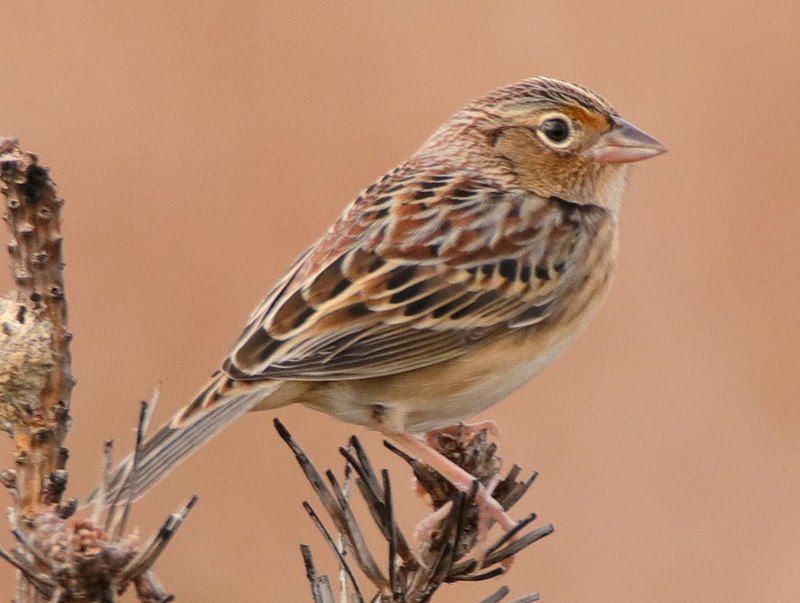
The Grasshopper Sparrow is a small species of bird found in the New World. It is part of the Ammodramus genus, which includes three species that live in grasslands and prairies.
Grasshopper sparrows have been seen in crop fields, and they can also take up residence in grasslands that have been re-established. They are well adapted to living in grassy environments, and thrive in these habitats.
They can be identified by their small size and brownish-streaked body. Grasshopper sparrows are well-known for their distinctive songs, which are composed of various chirps and trills.
These birds are important to the environment, as they help to control insect populations and disperse seeds. As a result, they are a valuable part of the local ecosystem.
| Kingdom | Animalia |
| Phylum | Chordata |
| Class | Aves |
| Order | Passeriformes |
| Family | Passerellidae |
| Genus | Ammodramus |
| Species | A. savannarum |
16. American Yellow Warbler
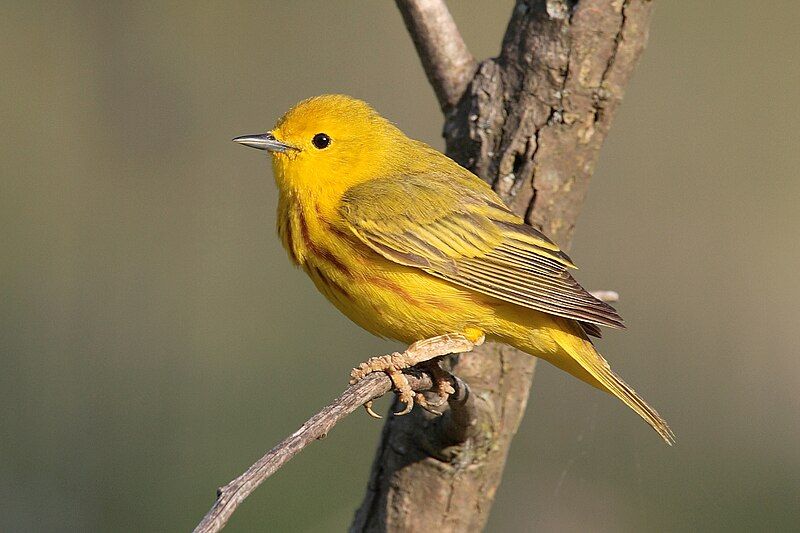
The yellow warbler is a type of New World warbler, which is a type of bird found in the Americas. These birds are most commonly found in North America, the Caribbean, and northern South America.
They are the most widespread species in the genus Setophaga, which is a diverse group of warblers. Yellow warblers have a bright yellow body with a tint of olive on their back and wings. They have a black eye line with white spectacles and a black bill.
They are small birds that usually measure between 12–14 cm in length. Yellow warblers are usually found in deciduous woodland habitats with thick understory vegetation. They feed on insects, spiders, and occasionally fruits and berries.
During the breeding season, they use a variety of nesting sites, such as shrubs, trees, and stumps, usually close to the ground. Yellow warblers are active and vocal birds. They sing a variety of trills and chirps that can be heard year-round in their habitats.
They are highly social birds that often form large flocks in winter.
| Kingdom | Animalia |
| Phylum | Chordata |
| Class | Aves |
| Order | Passeriformes |
| Family | Parulidae |
| Genus | Setophaga |
| Species | S. petechia |
Conclusion
Birds in Albany are abundant and diverse. There are many species of birds in Albany, from common backyard birds to rare species that can only be found in this region. As the city continues to grow, birds will remain an important part of the local ecology.
With proper care and conservation efforts, the birds of Albany will continue to thrive for many years to come.